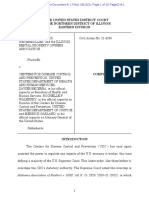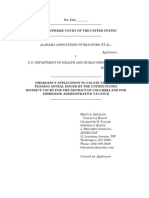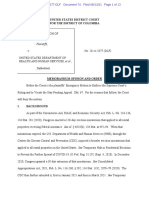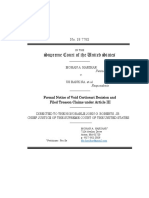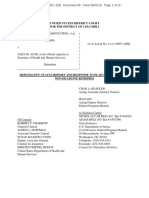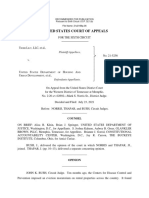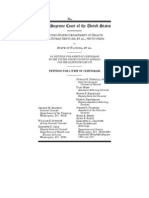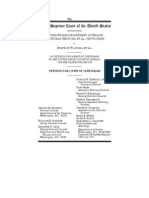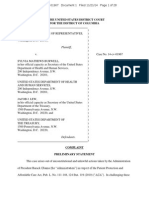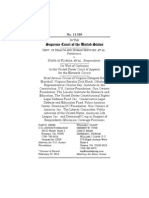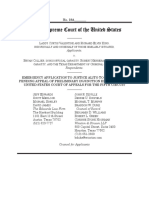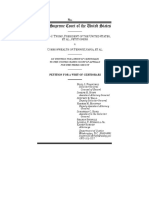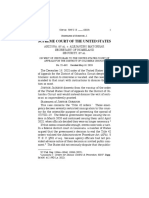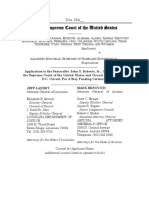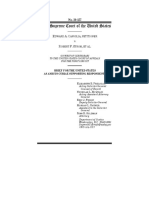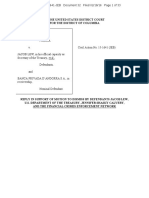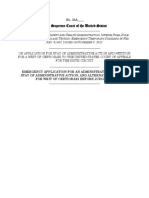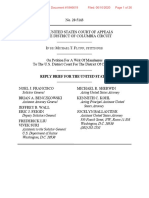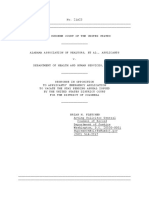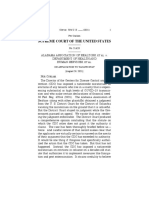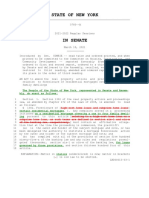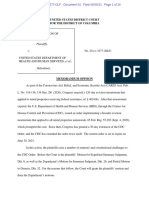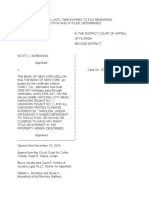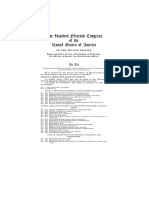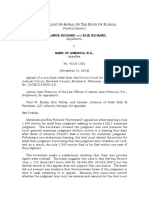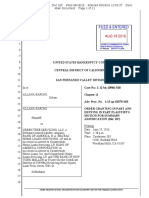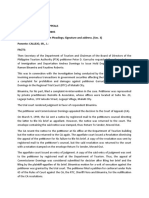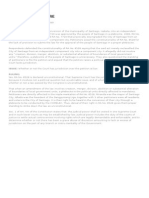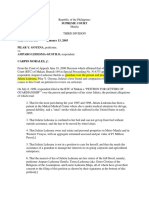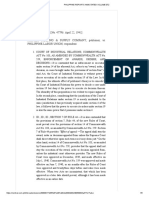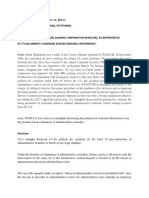USCA Case #21-5093 Document #1910536 Filed: 08/17/2021 Page 1 of 18
[ORAL ARGUMENT NOT YET SCHEDULED]
No. 21-5093
IN THE UNITED STATES COURT OF APPEALS
FOR THE DISTRICT OF COLUMBIA CIRCUIT
ALABAMA ASSOCIATION OF REALTORS®, et al.,
Plaintiffs-Appellees,
v.
U.S. DEPARTMENT OF HEALTH AND HUMAN SERVICES, et al.,
Defendants-Appellants
On Appeal from the United States District Court
for the District of Columbia
REPLY IN SUPPORT OF EMERGENCY MOTION
TO VACATE STAY PENDING APPEAL
Brett A. Shumate
Charlotte H. Taylor
Stephen J. Kenny
J. Benjamin Aguiñaga
JONES DAY
51 Louisiana Ave. NW
Washington, DC 20001
(202) 879-3939
bshumate@jonesday.com
Counsel for Appellees
�USCA Case #21-5093 Document #1910536 Filed: 08/17/2021 Page 2 of 18
TABLE OF CONTENTS
Page
TABLE OF AUTHORITIES ...............................................................................ii
INTRODUCTION.................................................................................................. 1
ARGUMENT .......................................................................................................... 2
I. The Government Has Not Met The Criteria For A Stay
Pending Appeal ............................................................................................... 2
II. The Law-of-the-Case Doctrine Has No Preclusive Effect Here .............. 5
CONCLUSION..................................................................................................... 12
CERTIFICATE OF COMPLIANCE ............................................................... 13
CERTIFICATE OF SERVICE ......................................................................... 14
i
�USCA Case #21-5093 Document #1910536 Filed: 08/17/2021 Page 3 of 18
TABLE OF AUTHORITIES
Page(s)
CASES
Belbacha v. Bush,
520 F.3d 452 (D.C. Cir. 2008)......................................................................... 5, 6
Berrigan v. Sigler,
499 F.2d 514 (D.C. Cir. 1974)............................................................................. 6
CASA de Maryland, Inc. v. Trump,
971 F.3d 220 (4th Cir. 2020) ............................................................................... 8
Christianson v. Colt Indus. Operating Corp.,
486 U.S. 800 (1988).................................................................................. 5, 10, 12
Chrysafis v. Marks,
No. 21A8, 2021 WL 3560766 (U.S. Aug. 12, 2021) ........................................... 4
FTC v. Am. Tobacco Co.,
264 U.S. 298 (1924).............................................................................................. 2
Halperin v. Kissinger,
807 F.2d 180 (D.C. Cir. 1986)............................................................................. 5
King v. Palmer,
950 F.2d 771 (D.C. Cir. 1991) (en banc)............................................................ 9
Marks v. United States,
430 U.S. 188 (1977).......................................................................................... 8, 9
Natural Res. Def. Council, Inc. v. Winter,
508 F.3d 885 (9th Cir. 2007) ............................................................................... 7
Oklahoma Press Publ’g Co. v. Walling,
327 U.S. 186 (1946).............................................................................................. 2
Paul v. United States,
140 S. Ct. 342 (2019) ........................................................................................... 3
Sherley v. Sebelius,
689 F.3d 776 (D.C. Cir. 2012)............................................................................. 6
Tiger Lily, LLC v. HUD,
--- F.4th ---, 2021 WL 3121373 (6th Cir. July 23, 2021) .............................. 2, 4
ii
�USCA Case #21-5093 Document #1910536 Filed: 08/17/2021 Page 4 of 18
TABLE OF AUTHORITIES
(continued)
Page(s)
TRW Inc. v. Andrews,
534 U.S. 19 (2001)................................................................................................ 3
United States v. Duvall,
740 F.3d 604 (D.C. Cir. 2013)................................................................... 8, 9, 10
United States v. Epps,
707 F.3d 337 (D.C. Cir. 2013)............................................................................. 9
Winslow v. FERC,
587 F.3d 1133 (D.C. Cir. 2009)........................................................................... 9
STATUTES
42 U.S.C. § 264 ............................................................................................... 2, 3, 11
iii
�USCA Case #21-5093 Document #1910536 Filed: 08/17/2021 Page 5 of 18
INTRODUCTION
Given that the government asks this Court to ignore the views of a
majority of the Supreme Court, one would expect a robust defense of the
CDC’s latest extension of the eviction moratorium. Instead, its opposition
offers little more than four pages of argument noteworthy only for what is left
uncontested. The government does not deny that the CDC’s most recent order
is merely an extension of a moratorium that a majority of the Supreme Court
has already concluded is likely unlawful. It does not acknowledge, much less
explain, its dramatic reversal regarding whether such an extension would be
legally permissible. And it does not defend the President’s admission that this
extension is unlikely to survive judicial scrutiny but would buy the government
more time to distribute rental assistance.
Instead, the government urges this Court to leave the stay undisturbed
merely because it did so at the start of June—before a majority of the Supreme
Court made clear that the moratorium could not remain in place past July 31,
before the government repeatedly announced that it lacked authority to adopt
even a narrower moratorium, and before the President conceded that the
CDC’s order (and this litigation) was merely a delay tactic. Nothing in the
law-of-the-case doctrine compels such a manifestly unjust result.
1
�USCA Case #21-5093 Document #1910536 Filed: 08/17/2021 Page 6 of 18
ARGUMENT
I. The Government Has Not Met The Criteria For A Stay Pending Appeal.
The government does not deny that it must satisfy all four traditional
factors to justify a continuation of the stay. Mot.12. Yet it makes barely any
attempt to do so, offering only a handful of points that collapse under scrutiny.
A. On the merits, the government asserts that “ ‘the plain text of 42
U.S.C. § 264(a)’ ” authorizes the moratorium, Opp.13, but fails to offer a good
explanation for how that reading avoids making the rest of § 264 superfluous,
Mot.14. At most, it claims that the inspection measures enumerated in
§ 264(a)’s second sentence “ ‘required express congressional authorization
under the Fourth Amendment’ ” under Oklahoma Press Publishing Co. v.
Walling, 327 U.S. 186 (1946), and FTC v. American Tobacco Co., 264 U.S. 298
(1924). Opp.14. But the Solicitor General declined to press that theory before
the Supreme Court, and for good reason. As the Sixth Circuit recently
explained, “[n]either case”—one of which was “decided in 1946, two years after
the Public Health Act of 1944”—“placed Congress on notice that giving the
Secretary authority to order inspections” would even “implicate the Fourth
Amendment.” Tiger Lily, LLC v. HUD, --- F.4th ---, 2021 WL 3121373, at *3
n.2 (6th Cir. July 23, 2021). And even if that account were plausible on its face,
it would render “more than half of th[e] text” of § 264 a historical footnote.
2
�USCA Case #21-5093 Document #1910536 Filed: 08/17/2021 Page 7 of 18
TRW Inc. v. Andrews, 534 U.S. 19, 31 (2001) (applying canon against
superfluity to construction that would make text “ ‘insignificant’ ”).
Superfluity aside, the government makes no attempt to square its
position with basic federalism and nondelegation canons, and it dismisses the
“major-questions doctrine”—the basis of Justice Kavanaugh’s concurring
opinion—as irrelevant in light of § 264’s “plain text.” Opp.14 (citations
omitted); see Mot.14-16. But the major-questions doctrine required Congress
to “expressly and specifically delegate” the authority to impose an eviction
moratorium, Paul v. United States, 140 S. Ct. 342 (2019) (statement of
Kavanaugh, J., respecting the denial of certiorari)—a description that does not
remotely describe § 264(a)’s delegation to the CDC to “make and enforce such
regulations as in [its] judgment are necessary to prevent the introduction,
transmission, or spread of communicable diseases.” The government also
suggests that Congress “embrace[d]” the CDC’s unlawful action by
acknowledging in appropriations legislation that the agency had issued the
moratorium “ ‘under’ ” § 264. Opp.14. But as the Sixth Circuit explained, that
legislation at most “gave force to the otherwise-unlawful order” until “January
31”; it “did not purport to alter the meaning of § 264(a)” or “grant the CDC
3
�USCA Case #21-5093 Document #1910536 Filed: 08/17/2021 Page 8 of 18
the power to extend the order further than Congress had authorized.” Tiger
Lily, 2021 WL 3121373, at *5.
B. The government has even less to say on the equities. It does not
dispute that a stay would substantially and irreparably injure Plaintiffs, that
the public interest rises and falls with the merits, or that the President’s
acknowledged use of litigation to buy time to extend an unlawful policy is
reason alone to end the stay. Mot.17-20. Instead, it emphasizes the uptick in
cases from the Delta variant, see Opp.16, but never explains why the CDC was
evidently willing to tolerate the risks of that strain until August 3. As the
government does not deny, the agency was aware of these risks both when it
announced in June that the moratorium would expire on July 31 and when it
allowed the moratorium to temporarily lapse after that date. Mot.19. In any
event, concerns about new variants evidently did not stop the Supreme Court
from enjoining the enforcement of part of New York’s eviction moratorium,
and there is no reason to conclude that those concerns will have any more
purchase here. Compare Chrysafis v. Marks, No. 21A8, 2021 WL 3560766, at
*1 (U.S. Aug. 12, 2021), with N.Y. Opp. at 14, Chrysafis, supra (Aug. 4, 2021).
4
�USCA Case #21-5093 Document #1910536 Filed: 08/17/2021 Page 9 of 18
II. The Law-of-the-Case Doctrine Has No Preclusive Effect Here.
Ultimately, the government’s only real argument is that the law-of-the-
case doctrine bars this Court from lifting the stay now because a motions panel
declined to do so in early June. But that doctrine “ ‘merely expresses the
practice of courts generally to refuse to reopen what has been decided,’ ” and
therefore leaves this Court with “the power to revisit prior decisions of its own
or of a coordinate court in any circumstance.” Christianson v. Colt Indus.
Operating Corp., 486 U.S. 800, 817 (1988); see Halperin v. Kissinger, 807 F.2d
180, 192 (Scalia, Circuit Justice, D.C. Cir. 1986) (“We have acknowledged in
the past that the law of the case is not an inexorable command that rigidly
binds a court to its former decisions”) (cleaned up). There are at least two
reasons why that discretionary doctrine does not bind this Court here.
A. To start, this Court has squarely held that “[a]n order denying
preliminary relief”—which unquestionably describes the motions panel’s June
ruling—“ ‘does not constitute the law of the case.’ ” Belbacha v. Bush, 520 F.3d
452, 458 (D.C. Cir. 2008); see Mot.21-22. Accordingly, even the government
admits that “[i]t is ‘of course’ true that the motions panel’s conclusions will not
bind the merits panel, as the motions panel explicitly recognized.” Opp.14.
5
�USCA Case #21-5093 Document #1910536 Filed: 08/17/2021 Page 10 of 18
The government nevertheless insists that these conclusions are binding
now because this case is “not before the merits panel.” Id. But it offers no
authority to support that distinction, which is difficult to square with the
unqualified language in Belbacha and other precedents. See, e.g., Sherley v.
Sebelius, 689 F.3d 776, 782 (D.C. Cir. 2012) (“An appellate court in a later
phase of the litigation … need not bind itself to the time-pressured decision it
earlier made”) (emphasis added); Berrigan v. Sigler, 499 F.2d 514, 518 (D.C.
Cir. 1974) (“The decision of a trial or appellate court whether to grant or deny
a preliminary injunction does not constitute the law of the case for the
purposes of further proceedings.”) (emphasis added).
The distinction also makes little sense. The preliminary-relief
“exception to the law-of-the-case doctrine arises from the nature” of the first
panel’s ruling, Sherley, 689 F.3d at 781, not the stage of the proceedings when
the case reaches the second panel. Specifically, the exception is based on the
fact that in considering a request for “preliminary relief,” appellate courts are
often left with “briefing and argument abbreviated or eliminated by time
considerations” and must merely “predict[] … that the plaintiffs probably or
likely will or will not succeed on the merits.” Id. at 782. Those concerns exist
whether the preliminary-relief decision is invoked at the merits stage or
6
�USCA Case #21-5093 Document #1910536 Filed: 08/17/2021 Page 11 of 18
before. Presumably, that is why a panel considering a preliminary-injunction
appeal is not bound by the conclusions of an earlier motions panel staying (or
declining to stay) that injunction. See, e.g., Natural Res. Def. Council, Inc. v.
Winter, 508 F.3d 885 (9th Cir. 2007) (resolving preliminary-injunction appeal
and vacating motions panel’s stay of the injunction).
B. In any event, a motions panel’s order cannot be binding in light of
changed circumstances. Mot.22-24. Otherwise, this Court would be powerless
to lift the stay even if 99% of the population were vaccinated, the daily average
of cases plummeted to levels not seen since February 2020, and the CDC
announced that the moratorium would be extended indefinitely until sufficient
economic recovery had occurred. See Mot.21. The government agrees that
the law-of-the-case doctrine must yield in light of intervening developments,
but contends that there has been no relevant change in circumstances here—
notwithstanding the significant actions taken by the Supreme Court and the
Executive Branch in the wake of the motions panel’s decision. See Opp.15.
That position suffers from at least two fundamental flaws.
1. a. To start, the government’s request that this Court disregard
the views of a majority of the Supreme Court is mystifying. Although the
government contends that the Supreme Court’s ruling is not technically
7
�USCA Case #21-5093 Document #1910536 Filed: 08/17/2021 Page 12 of 18
“ ‘binding,’ ” Opp.15, it has no response to the fact that even non-binding
authority can constitute a relevant intervening development in the law, see
Mot.22-23. That may explain why in the days leading up to August 3, the
Executive Branch repeatedly stated that it could not extend the moratorium—
even in a slightly narrower form—in light of the Supreme Court’s ruling.
Mot.7-9. Whether or not this Court has the “technical authority” to depart
from that ruling, it should not “deny[] the Supreme Court action its obvious
and relevant import.” CASA de Maryland, Inc. v. Trump, 971 F.3d 220, 230
(4th Cir.) (Wilkinson, J.), reh’g en banc granted, 981 F.3d 311 (4th Cir. 2020).
To justify its about-face, the government invokes (Opp.15) this Court’s
approach to Marks v. United States, 430 U.S. 188 (1977), but that misses the
forest for the trees. Whether or not Justice Kavanaugh’s opinion is formally
controlling under Marks—or whether Marks even governs Supreme Court
rulings concerning applications for emergency relief—there is no conceivable
justification for a lower court to “decide a case contrary to how a majority of
the Supreme Court … would decide the case.” United States v. Duvall, 740
F.3d 604, 617 n.8 (D.C. Cir. 2013) (Kavanaugh, J., concurring in the denial of
rehearing en banc). Such an approach would not respect “[v]ertical stare
8
�USCA Case #21-5093 Document #1910536 Filed: 08/17/2021 Page 13 of 18
decisis”—either “in letter” or “in spirit.” Winslow v. FERC, 587 F.3d 1133,
1135 (D.C. Cir. 2009) (Kavanaugh, J.).
In any event, the government misreads this Court’s precedents.
According to the government, this Court has held that “the votes of dissenting
Justices may not be combined with that of a concurring Justice to create
binding law.” Opp.15 (quoting App.68a). To support that proposition, the
government points to the following language from King v. Palmer, 950 F.2d
771 (D.C. Cir. 1991) (en banc): “[T]he narrowest opinion … must embody a
position implicitly approved by at least five Justices who support the
judgment.” Id. at 781; accord United States v. Epps, 707 F.3d 337, 348 (D.C.
Cir. 2013). But as then-Judge Kavanaugh explained, there is no need to “read
King to direct that we decide a case contrary to how a majority of the Supreme
Court in the governing precedent would decide the case.” Duvall, 740 F.3d at
617 n.8 (Kavanaugh, J., concurring in the denial of rehearing en banc). Rather,
all that King establishes is that “looking to just the concurrence and dissent
alone will never be enough to determine whether one of the opinions is the
binding opinion under Marks.” Id. That is because “an opinion is the binding
opinion only when it will lead to results with which a majority of the Court
would agree in all future cases,” and “that analysis can be logically conducted
9
�USCA Case #21-5093 Document #1910536 Filed: 08/17/2021 Page 14 of 18
only by looking at all of the opinions in the Supreme Court case at issue.” Id.
And here, that opinion is plainly Justice Kavanaugh’s concurrence—as the
White House itself has acknowledged. This Court should therefore “strive to
reach the result that a majority of the Supreme Court would have reached
under the opinions in the governing precedent.” Id. at 616.
Indeed, by stating that he voted “at this time” to deny Plaintiffs’
application, App.56a, Justice Kavanaugh necessarily indicated that Plaintiffs
could again ask the Supreme Court to vacate the stay at a later date—a point
that the government evidently does not dispute. See Opp.5. Yet under the
government’s view of the law-of-the-case doctrine, Plaintiffs were required to
undergo time-consuming proceedings in the lower courts before seeking this
relief even though those courts were required to rule against them. This Court
should not use a doctrine meant to increase the “efficiency of the judicial
process,” Christianson, 486 U.S. at 816, to compel such a meaningless ritual.
b. The government also suggests that “it is impossible to know” how
the Supreme Court would resolve this request to vacate the stay. It should
have asked the White House. As the government now tells it, the four
dissenting Justices may have voted to vacate the stay solely because they
thought that “changed pandemic conditions meant that the eviction
10
�USCA Case #21-5093 Document #1910536 Filed: 08/17/2021 Page 15 of 18
moratorium was no longer necessary to prevent the spread of COVID-19.”
Opp.15-16. But neither Plaintiffs nor the government ever presented such a
reading of § 264(a) to the Supreme Court. To the contrary, the government
repeatedly urged the Justices to “defer[]” to the CDC as the “ ‘expert best
positioned to determine the need for such preventative measures.’ ” S. Ct.
Opp. 12, 24; see id. at 33-34. Otherwise, the CDC’s determinations of necessity
under § 264(a) would remain subject to perpetual judicial reexamination—a
prospect the government presumably wishes to avoid. And the snippets the
government quotes from Plaintiffs’ Supreme Court application, see Opp.15-16,
explained why the equities—not the merits—favored vacating a stay.
Plaintiffs have never argued that the moratorium only became unlawful when
the public-health situation improved; indeed, they filed this action in late
November 2020.
Confirming the point, the Executive Branch—at least until August 3—
understood the position of the four dissenting Justices to be perfectly clear:
Those Justices (at a minimum) agreed with Justice Kavanaugh “that the CDC
could not grant such an extension without clear and specific congressional
authorization.” Mot.8 (citation omitted); see Mot.7-9. The only thing that has
changed is that the White House now believes that litigating a fourth extension
11
�USCA Case #21-5093 Document #1910536 Filed: 08/17/2021 Page 16 of 18
of the moratorium will give it “the ability, if we have to appeal, to keep this
going for a month at least” and “by that time” presumably “get a lot of” rental
assistance out the door. Mot.10 (citation omitted).
2. Finally, even if this Court were somehow free to ignore the views
of a majority of the Supreme Court, adhering to the law-of-the-case doctrine
here “would work a manifest injustice” given the Executive Branch’s misuse
of agency action and the judicial process. Christianson, 486 U.S. at 817
(citation omitted); see Mot.23-24. The government does not even
acknowledge, much less respond to, this point.
CONCLUSION
This Court should vacate the stay no later than August 19, 2021.
Dated: August 17, 2021 Respectfully Submitted,
/s/ Brett A. Shumate
Brett A. Shumate
Charlotte H. Taylor
Stephen J. Kenny
J. Benjamin Aguiñaga
JONES DAY
51 Louisiana Ave. NW
Washington, DC 20001
(202) 879-3939
bshumate@jonesday.com
Counsel for Appellees
12
�USCA Case #21-5093 Document #1910536 Filed: 08/17/2021 Page 17 of 18
CERTIFICATE OF COMPLIANCE
1. This document complies with the word limit of Fed. R. App. P.
27(d)(2)(C) because, excluding the parts of the document exempted by Fed. R.
App. P. 32(f) and D.C. Circuit Rule 32(e)(1), this document contains 2,553
words.
2. This document complies with the typeface and type-style
requirements of Fed. R. App. P. 27(d)(1)(E) and 32(a)(5) and (a)(6) because
this document has been prepared in a proportionally spaced typeface using
Microsoft Word in 14-point Century Expd BT typeface.
/s/ Brett A. Shumate
13
�USCA Case #21-5093 Document #1910536 Filed: 08/17/2021 Page 18 of 18
CERTIFICATE OF SERVICE
The undersigned certifies that, on this 17th day of August 2021, I filed
the foregoing brief using this Court’s Appellate CM/ECF system, which
effected service on all parties.
/s/ Brett A. Shumate
14




